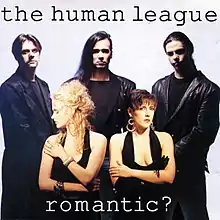Romantic?
Romantic? is the sixth studio album by English synth-pop band the Human League. It was issued by Virgin Records in 1990 and was the band's first album of new material in four years. Romantic? had several producers, most notably Martin Rushent, who worked with the Human League on their biggest commercial success (1981's Dare) and had walked out of the recording sessions for its 1984 follow-up (Hysteria). Also producing several tracks is Mark Brydon, who would be one half of musical duo Moloko several years later.
| Romantic? | ||||
|---|---|---|---|---|
 | ||||
| Studio album by | ||||
| Released | 17 September 1990 | |||
| Studio | Genetic Studios, Streatley, Berkshire | |||
| Length | 43:37 | |||
| Label | Virgin Records (UK) A&M Records (US) | |||
| Producer | ||||
| The Human League chronology | ||||
| ||||
| Singles from Romantic? | ||||
| ||||
| Review scores | |
|---|---|
| Source | Rating |
| AllMusic | |
| Chicago Tribune | |
| Entertainment Weekly | (B+)[3] |
| Ottawa Citizen | |
| Rolling Stone | |
| The Rolling Stone Album Guide | |
| Smash Hits | 6/10[7] |
| St. Petersburg Times | |
| Telegram & Gazette | |
At the time of the album's release, the Human League had reached the nadir of a decline in popularity following the success of Dare nine years prior; this fall from grace was reflected in the song "The Stars Are Going Out," in which the band reflects upon their loss of fame and its impact on them. The song one writer called a "pointless and bland filler,"[9] was ditched as a potential third single.
The album signalled a critical and commercial low point for the band, which led to their long-standing contract with Virgin Records being terminated.[10] The only significant success came from the album's first single "Heart Like a Wheel", which peaked at No. 29 on the UK Singles Chart and No. 32 on the U.S. Billboard Hot 100. The second single "Soundtrack to a Generation" charted at No. 77 in the UK. The album itself peaked at No. 24 on the UK Albums Chart, and as a result the band moved to East West Records to release their next album, 1995's Octopus.
The Human League's live performance of "The Stars Are Going Out" on Later... with Jools Holland in 1995 was included on their 2003 The Very Best of the Human League DVD.
Track listing
All tracks are written by Philip Oakey and Neil Sutton, except where noted.
| No. | Title | Writer(s) | Length |
|---|---|---|---|
| 1. | "Kiss the Future" | 4:13 | |
| 2. | "A Doorway?" |
| 4:21 |
| 3. | "Heart Like a Wheel" |
| 4:30 |
| 4. | "Men Are Dreamers" |
| 3:54 |
| 5. | "Mister Moon and Mister Sun" | 4:42 |
| No. | Title | Writer(s) | Length |
|---|---|---|---|
| 6. | "Soundtrack to a Generation" | 4:35 | |
| 7. | "Rebound" | 3:54 | |
| 8. | "The Stars Are Going Out" | 4:05 | |
| 9. | "Let's Get Together Again" |
| 5:01 |
| 10. | "Get It Right This Time" |
| 4:12 |
| Total length: | 43:37 | ||
Chart performance
| Chart (1990) | Peak position |
|---|---|
| UK Albums Chart[11] | 24 |
References
- https://www.allmusic.com/album/r9614
- DeKnock, Jan (27 September 1990). "Home Entertainment....Recordings". Chicago Tribune. p. 7.
- Sandow, Greg (21 September 1990). "Music Review: Romantic? (1990)". Entertainment Weekly. Retrieved 23 June 2013.
- Erskine, Evelyn (21 September 1990). "Liberty; Duran Duran incites dancing with sassy funk". Ottawa Citizen. p. D6.
- Wild, David (4 October 1990). "Good Effort by Singer With a Bad Attitude". Rolling Stone. Archived from the original on 4 April 2020.
- Considine, J. D. (2004). "The Human League". In Brackett, Nathan; Hoard, Christian (eds.). The New Rolling Stone Album Guide (4th ed.). Simon & Schuster. pp. 397–98. ISBN 0-7432-0169-8.
- Soutar, Mike (19 September 1990). "The Human League: Romantic? (Virgin)". Smash Hits. No. 308.
- Donahue, Steve (9 November 1990). "Sound Bites". St. Petersburg Times. p. 99.
- Semon, Craig S (27 January 1991). "Is it enough that Human League gets 'Romantic?'". Telegram & Gazette. p. 10.
- "The sound of the crowd (hopefully)". The List (266): 36. 3 November 1995. Retrieved 25 April 2019.
- "Artist Chart History - The Human League". Official Charts Company. Retrieved 22 June 2013.